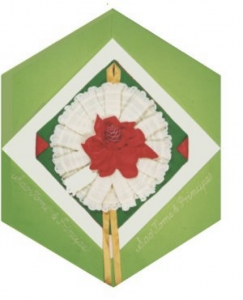São Tomé e Príncipé

The Block
Using materials contributed by Agapito Mendes Dias, Denise Dompierre stitched the block. A rich, deep pink Porcelana Rose, São Tomé e Príncipe’s national flower, is the central attraction. Pleated pin-tucked cotton, with eyelet lace trim, cushions the flower, and replicates the style of decoration found on the sleeves and waist area of traditional shirts. A bright green background, symbolic of both the hopeful nature of the people and the nation’s lush, natural beauty, is gently folded in on each side revealing a different coloured fabric underneath. The pair of triangles and the golden ribbons embellishing the piece represent the two distinct islands that make up the country.
Cultural Profile
São Tomé e Príncipe, one of Africa’s smallest countries, straddles the Equator in the Gulf of Guinea and consists of two main islands that form part of a chain of extinct volcanoes. The islands are known for their rich biodiversity and pristine rainforests. During the 16th century, cultivation of the land led to a thriving sugar economy, making São Tomé e Príncipe the world’s largest exporter of sugar. Production declined over the next hundred years and by the 1800s coffee and cocoa were the country’s mainstays. To this day, São Tomé e Príncipe is still heavily dependent on the export of cocoa as well as the importation of most goods, including food. The official language is Portuguese and the population, over 80 percent of whom live on São Tomé, is predominantly of African descent.
The culture of São Tomé e Príncipe, strongly influenced by the Portuguese, is a homogenous one with many African elements incorporated into the cooking, customs, beliefs and dress of the people. Leve leve, which means ‘Take it easy’, is central to the islands’ way of life. São Toméan music is a blend of Latin and African rhythms, while the Tchioli and the Danço Congo are dance and music theatre plays that are also popular on the islands. The country is known for weaving, woodcarving and basketry created with traditional designs.
São Tomé e Príncipe is not a rich nation, but what the citizens lack materially, they more than make up for in their richness of life and generosity of spirit.
Immigration records indicate that people have been coming to Canada from these islands since 1974, although they still make up only a minute portion of the population. The most recent census records only 30 São Toméans in this country.
Sponsor: Valade & Bougie Families, in memoriam Jennifer Valade
